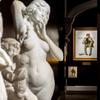It's Later Than You Think: Modern Momento Mori Painting
- April 27, 2020 13:16

Death has frightened and fascinated from the beginning of time and is one of the most enduring subjects in art history. One genre of painting called memento mori provides a particularly impassioned take on the subject and continues to inspire artists today.
A Latin phrase literally meaning “remember that you must die,” memento mori is a reminder of the fundamental truth of death. Everything is temporary, and we are all destined for the same fate. It is an uncomfortable message, but it can be a beautiful commentary on leading a more meaningful and fulfilled life.
Memento mori can appear in many forms of art — in religious works, portraiture and perhaps most notably in the sub-genre of still-life vanitas painting. Vanitas painting had its heyday in the 16th and 17th centuries in Europe, particularly the Netherlands, where a period of wealth and rapid growth known as the Dutch Golden Age led to precious objects and luxury items appearing increasingly in still-life paintings. The Dutch were proud of their prosperity and wanted artworks that reflected their wealth, but that pride had to be tempered according to their Christian faith. In fact, the term “vanitas” originally comes from the Bible in the opening lines of the book of Ecclesiastes: “Vanity of vanities, saith the Preacher, vanity of vanities, all is vanity.” Because of the influence of the Church, these still lifes represented beauty and wealth while also hinting at the transience of both.
Suffice to say, the symbolism is rich in these works. References included wilting flowers, the remnants of a meal, timepieces, extinguished candles and, most startling, skulls. They provide a pointed reminder of the duality of grandeur and that, ultimately, all worldly things are vanities. These artworks served as warnings that urged the viewer to consider their own mortality and were a powerful tool to inspire people to live better.

The genre had a resurgence in the 20th century as Post-Impressionist artists sought to explore emotion through painting. Cézanne, known for his still lifes, employed the genre later in his life with compositions of skulls piled on tables. Van Gogh also painted skulls and vases of wilting cut flowers with dynamic, emotional brushstrokes.
There are also homages in Academic-style art of the early 20th century. Shown in 1912 at the Royal Academy, British artist John Henry Amshewitz’s work entitled Death’s Arrest takes a Neoclassical approach to the memento mori genre. The theatrical scene is set in a garden on a coastal villa. In it, we see a young musician strumming his lute surrounded by the best things life has to offer, but he is burdened by the grim reaper — death personified — clinging to his tunic. Figures of a graceful woman, cupid and a dancing jester accompany him, representing beauty, love and mirth, but they are juxtaposed by classic vanitas symbols of wilting flowers, soap bubbles and an impermanent wind blowing through the composition. Even the troubadour himself is a reminder that nothing lasts; the music he creates is ephemeral and of the moment.
Memento mori paintings can take two approaches. They can be a warning on the fleeting nature of life like in Amshewitz’s piece, or they can be a hopeful reminder to enjoy life while you can. Austrian genre and portrait artist Albert Janesch’s 1933 self-portrait is the latter. The artist joyfully sips a cocktail as he paints while his beloved wife and dog keep him company. However, in a moment of self-awareness for the artist, he includes a skeleton peering over their shoulders as a reminder that death is not far behind.
For Janesch, this composition was a motivator to lead a more meaningful life filled with the things he loved. The juxtaposition of his healthy, vivacious demeanor next to the pallid skeleton is jarring but not morbid. There is an element of happy decadence to this painting, and perhaps a knowing look in the artist’s eye, presenting a challenge to the message of mortality itself. Memento mori in portraiture provided a clever way to immortalize the sitter, and Janesch is able to live on through this self-portrait. He conquers death in the only way possible — by being remembered.
Today’s audiences are just as enthralled by this seemingly dark subject. In 2007, Damien Hirst created one of the most widely recognized works of contemporary art with his sculpture For the Love of God, which consists of a platinum cast of a human skull encrusted in over 8,000 diamonds. Artists and the public will never tire of investigating the fleeting nature of life, and memento mori artwork will continue to serve as an ardent reminder to appreciate the present.
About M.S. Rau:
M.S. Rau has spent more than 100 years earning the trust of discerning collectors worldwide. Located in the heart of New Orleans’ historic French Quarter, our peerless showroom houses one of the world’s most extensive and stunning collections of museum-quality fine art by artists such as Claude Monet and William Bouguereau, 18th- and 19th-century antiques and breathtaking jewelry, including rare colored diamonds.
















_(Medium)100x100_c.jpg)




